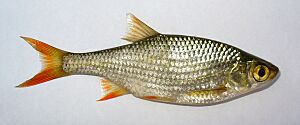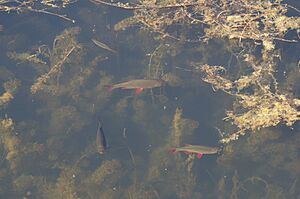Common rudd facts for kids
Quick facts for kids Common rudd |
|
|---|---|
 |
|
| Conservation status | |
| Scientific classification | |
| Synonyms | |
|
The common rudd (Scardinius erythrophthalmus) is a type of freshwater fish. It lives in lakes, rivers, and ponds. You can find rudd across many parts of Europe and central Asia. They are common in areas around the North Sea, Baltic Sea, Black Sea, Caspian Sea, and Aral Sea. Rudd often swim near the bottom and in open water.
Contents
How to Spot a Common Rudd
Rudd look a lot like another fish called the roach (Rutilus rutilus). It can be tricky to tell them apart. One easy way is to look at their eyes. A rudd has yellow eyes. A roach has a red spot above its pupil.
Rudd have an upturned mouth. This helps them eat food floating on the water's surface. Their dorsal fin is set further back on their body. You can even see this on very young rudd.
Another difference is the scales. Rudd usually have only one or two scales between their pelvic fins and anal fins. Roach have about five scales in that area. The skin of a rudd is yellowish-green. A roach's sides are more bluish. Rudd also have fewer soft rays in their dorsal fin. They have 8 or 9, while roach have 10 to 12.
There is a special type of common rudd called the golden rudd. This fish has a shiny gold body. Many people like to keep golden rudd in their ponds.
Rudd can grow to about 45–50 cm (18–20 in) long. The average size is about 25 cm (10 in). Their dorsal fin and pectoral fins are grayish with a hint of red. All their other fins are bright red. This red color is how the fish got its name "rudd" centuries ago.
Rudd Around the World
Sometimes, people move fish to new places. This can happen on purpose or by accident. When a species is moved to a new area and starts to cause problems, it's called an invasive species. The common rudd has been introduced to many countries. These include Ireland, the United States, Morocco, Madagascar, Norway, Tunisia, New Zealand, Canada, and Spain.
In the United States, rudd have been found in many states. This includes Alabama, Arkansas, Colorado, Connecticut, Georgia, Illinois, Indiana, Kansas, Massachusetts, Maine, Missouri, Nebraska, New Jersey, New York, Oklahoma, Pennsylvania, South Dakota, Texas, Vermont, Virginia, West Virginia, and Wisconsin.
Rudd were brought to New Zealand illegally in the 1960s. They have spread widely there. These fish can harm the natural plants and animals in New Zealand's waters.
Rules About Rudd in the US
Rudd were first seen in the United States around 1925. Because they can be an invasive species, some states have rules about them. For example, in Tennessee, it is against the law to own or move live rudd.
In Alabama, it is also illegal to own, sell, or bring rudd into the state. This rule also applies to roach and any fish that are a mix of rudd and roach. Rudd were first reported in Alabama around 1987.
What Do Rudd Eat and Where Do They Live?
Rudd like to live in clear water that has lots of plants. They eat aquatic plants, especially when the water is warmer than 18 °C (64 °F). They also hunt for small living creatures near the water's surface. Rudd prefer waters that have a good amount of nutrients.
They like shallow areas in lakes and slow-moving parts of rivers. These spots usually have many weeds. Female rudd can lay up to 200,000 eggs. They lay their eggs on underwater plants.
Young rudd eat tiny water animals called zooplankton. They also eat aquatic insects and sometimes other small fish. Older rudd, which can be about 45 cm (18 in) long and weigh around 1.4 kg (3 lb), mostly eat water plants. A rudd can eat up to 40% of its body weight in plants every day. About 80% of this food is released as waste. This waste adds nutrients back into the water.
Rudd can live in many different water conditions. They can handle a wide range of temperatures. They can also live in waters that are rich in nutrients or even a bit polluted. In labs, rudd have been shown to breed with the U.S. golden shiner fish. Some rudd are silver, and some are gold. They are sometimes sold as fish for garden ponds.
Rudd can live for up to 17 years. They usually become old enough to have babies when they are 2 or 3 years old.



